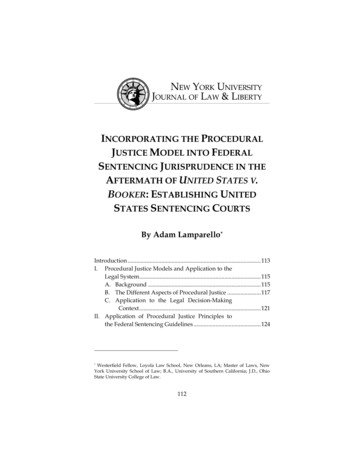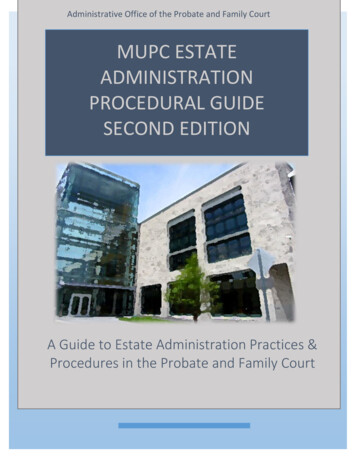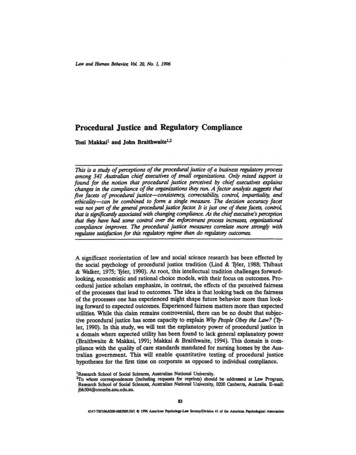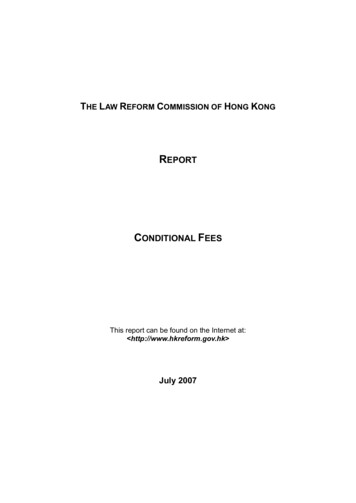
Transcription
INCORPORATING THE PROCEDURALJUSTICE MODEL INTO FEDERALSENTENCING JURISPRUDENCE IN THEAFTERMATH OF UNITED STATES V.BOOKER: ESTABLISHING UNITEDSTATES SENTENCING COURTSBy Adam Lamparello*Introduction .113I. Procedural Justice Models and Application to theLegal System.115A. Background .115B. The Different Aspects of Procedural Justice .117C. Application to the Legal Decision-MakingContext.121II. Application of Procedural Justice Principles tothe Federal Sentencing Guidelines .124Westerfield Fellow, Loyola Law School, New Orleans, LA; Master of Laws, NewYork University School of Law; B.A., University of Southern California; J.D., OhioState University College of Law.*112
2009]Establishing United States Sentencing Courts113III. Reforming Federal Sentencing Law Based onProcedural Justice Research: Establishing UnitedStates Sentencing Courts . 130A. The Guidelines Should Not Be Presumptiveor Otherwise Retain Substantial Influencein the Sentencing Decision. 1311. Composition of Sentencing Courts . 1312. Written Opinions. 1333. Meaningful Appellate Review. 134B. Criticisms. 134III. Conclusion. 137“Research consistently finds that people’s primary basis for accepting or rejecting the decisions made by police officers andjudges is their evaluation of the fairness of the procedures usedby the authorities to make those decisions.”1INTRODUCTIONIn United States v. Booker, the United States Supreme Courtheld that the Federal Sentencing Guidelines (“Guidelines”) suffered from a fatal constitutional infirmity and therefore declaredthe Guidelines “effectively advisory.”2 In light of Booker, this article proposes a solution to the current problems faced in federalsentencing jurisprudence by proposing a process-oriented modelto sentence criminal defendants. This theory is predicated uponempirical data developed by social psychologists in the area ofprocedural justice.As set forth infra, the relevant data supports the propositionthat positive valuations of sentencing outcomes will depend upon,and be influenced by, perceptions regarding the fairness of the1 Tom Tyler, Obeying the Law in America: Procedural Justice and the Sense ofFairness,ISSUES OF te.gov/journals/itdhr/0701/ijde/tyler.htm (emphasis added).2 543 U.S. 220, 245 (2005).
114New York University Journal of Law & Liberty[4:112sentencing process. 3 Specifically, research suggests that satisfactionwith outcomes is predicated upon, and closely related to, perceptionsof procedural fairness. As a result, factors such as “voice” (the ability of individuals directly affected by a specific decision to havetheir opinions heard, considered, and respected by the decisionmaker) and quality of treatment directly impact fairness valuations.Based on these findings, empirical data underscores that individuals are more likely to accept unfavorable outcomes if they believethat the attendant processes were fair and/or equitable.4 The implication of this research is that process matters. Namely, acceptanceof, and satisfaction with, decision-making and/or rule promulgation—particularly if unfavorable—depends heavily upon subjectiveperceptions of procedural fairness. Moreover, perceptions regarding institutional legitimacy, competency, and trust are closely connected to the manner in which individuals are treated and decisionsare effectuated. Accordingly, based on research in the area of procedural justice, this article proposes a process-based model for federal sentencing practice that vests with select participants—thecourts and criminal defendants—primary control over the ultimatesentencing determination and argues that sentencing decisionsmust be the product of procedures that are likely to be viewed asfair, equitable, reliable, and legitimate. 5Part I of this article provides an overview of research in thefield of procedural justice, with particular emphasis on those factors that most heavily influence perceptions of fairness. Part IIbriefly discusses the adoption and implementation of the Guidelines and concludes that the Guidelines’ outcome-determinativeSee discussion infra Part I; see also JOHN THIBAUT & LAURENS WALKER, PROCEDURALJUSTICE: A PSYCHOLOGICAL ANALYSIS 118 (1975); John Thibaut & Laurens Walker, ATheory of Procedure, 66 CAL. L. REV. 541, 551 (1978).4 See generally Tom Tyler, What Is Procedural Justice?: Criteria Used by Citizens to Assessthe Fairness of Legal Procedures, 22 LAW & SOC’Y REV. 103 (1988); Tyler, supra note 1.5 There exists a considerable body of literature in the criminal law context in whichscholars advocate the development of a “common law” of sentencing whereby judicially created principles develop a jurisprudence to guide future cases. See, e.g.,Douglas A. Berman, A Common Law for This Age of Federal Sentencing, 11 STAN. L. &POL’Y REV. 93, 94 (1999).3
2009]Establishing United States Sentencing Courts115model resulted in decisions that were the product of unfair processes and were themselves inherently unjust. Part III proposes thatthe United States Sentencing Commission, in conjunction withCongress, as well as state legislatures throughout the country,should consider creating independent “sentencing courts” whosesole function is to conduct separate sentencing hearings for defendants already convicted at trial.I. PROCEDURAL JUSTICE MODELS AND APPLICATION TO THE LEGALSYSTEMA. BACKGROUNDEarly social science research advanced the theory of distributivejustice that ”people were more likely to perceive that an interactionwith the legal system was fair if they perceived that the decision orthe outcome was fair.”6 This theory asserted that “people base theirperceptions of justice on social comparison information as theycompare how their outcomes fall relative to the outcomes of others,and whether the outcomes they receive are equitable in terms of therelative contributions and rewards of all the participants in the interaction.”7 Some distributive justice theorists suggested that “people compare the apportionment of outcomes based on need or ‘deservingness’ criteria.” 8 In essence, “distributive justice theoristsview people as primarily self-interested and as seeking to maximizetheir rewards (or resources) from their interactions with others.They therefore believe that people tend to focus on their outcomes6 Jill Howieson, Perceptions of Procedural Justice and Legitimacy in Local Court eson92 text.html.7 Id. (citing J. Adams, Inequity in Social Exchange, in 2 ADVANCES IN EXPERIMENTAL &SOC. PSYCHOL. (L. Berkowitz ed., 1965)).8 Id. at para. 26 (citing M.J. Lerner, The Justice Motive in Human Relations: SomeThoughts on What We Know and Need to Know About Justice, in THE JUSTICE MOTIVE INSOCIAL BEHAVIOUR (M.J. Lerner & C. Lerner eds., 1981); M. Deutsch, Justice in “TheCrunch,” in THE JUSTICE MOTIVE IN SOCIAL BEHAVIOUR, supra).
116New York University Journal of Law & Liberty[4:112from a legal dispute resolution procedure as the source of their fairness and satisfaction ratings.”9Research soon showed that, irrespective of the actual outcome,procedural fairness directly and positively impacted disputants’satisfaction with and acceptance of a resolution.10 Importantly, thisobservation was consistent regardless of the parties’ interest in theoutcome of the dispute, at both individual and institutional levels.11Perhaps more importantly, research revealed that individuals werefar more likely to accept negative outcomes if they believed that theprocedures in effectuating such outcomes were fundamentallyfair.12 As such, it became apparent that process mattered and that“procedural justice strongly influences institutional legitimacy and,through it, the acceptance of institutional decisions.”13Critically, however, procedural justice theorists do not “excludedistributive justice as an important concern in people’s perceptionsof the justice and legitimacy of the legal system.”14 Instead, distributive justice “simply seeks to highlight the importance of the oftenneglected procedural aspects of decision making, as opposed to[merely] the end result.”15 Thus,[t]he perception of the fairness of the outcomes still has animpact on people’s impressions of their experience with legalauthorities, . . . [but w]hen the outcome information doesarrive, it is usually interpreted in terms of already-existingId.See id. at para. 27 (citation omitted).11 Id. (citing E. Allan Lind, et al., Individual and Corporate Dispute Resolution: UsingProcedural Fairness as a Decision Heuristic, 38 ADMIN. SCI. Q. 224, 224 (1993)).12 Id. at para. 28 (citing Mark Fondacaro, Toward a Synthesis of Law and Social Science:Due Process and Procedural Justice in the Context of National Health Care Reform, 72DENV. U. L. REV. 303, 305 (1995)).13 Id. (quoting Fondacaro, supra note 12, at 305).14 Id. at para. 30.15 Id.910
2009]Establishing United States Sentencing Courts117beliefs about the [decision-making] authority, namely[,] existing impressions of its procedural justice.16The concept of procedural justice is expressed in various formsand applicable to numerous contexts. For purposes of clarity, theaspect of procedural justice most relevant to this article is thatwhich is concerned with administration of justice and legal proceedings in a procedurally fair and transparent manner.17B. THE DIFFERENT ASPECTS OF PROCEDURAL JUSTICEProcedural justice encompasses three distinct concepts, as developed by John Rawls in A Theory of Justice: (1) perfect proceduraljustice; (2) imperfect procedural justice; and (3) pure proceduraljustice.18 The concept of perfect procedural justice is characterizedby the following two elements: first, an independent criterion ofwhat is a fair allotment—a criterion defined separately from andprior to the procedure which is to be followed; and, second, a procedure that is sure to give that desired outcome.19 In essence, perfectprocedural justice strives to ensure that certain outcomes are reliably and consistently produced. 20 Alternatively, imperfect procedural justice, while establishing procedures for outcome fairness,does not guarantee that a particular result will be achieved.21 Lastly,pure procedural justice includes no independent criterion for theright result. Instead, it requires a correct or fair procedure resultingin a belief that the outcome—whatever it is—is likewise correct or16 Id. (citing Kees Van den Bos et al., Evaluating Outcomes by Means of the Fair ProcessEffect: Evidence for Different Processes in Fairness and Satisfaction Judgments, 74 J.PERSONALITY & SOC. PSYCHOL. 1493, 1498 (1998)).17 See generally Stephanos Bibas, Transparency and Participation in Criminal Procedure,81 N.Y.U. L. REV. 911, 946–53 (2006).18 See JOHN RAWLS, A THEORY OF JUSTICE 73–75 (rev. ed. 1999).19 See Carole Necole Brown, Casting Lots: The Illusion of Justice and Accountability inProperty Allocation, 53 BUFF. L. REV. 65, 104 (2005).20 See id.21 See Wojciech Sadurski, Law’s Legitimacy and ‘Democracy-Plus,’ 26 OXFORD J. LEGALSTUD. 377, 397–99 (2006).
118New York University Journal of Law & Liberty[4:112fair, provided that the procedure has been properly followed.22 Ultimately, as stated by Jerry Mashaw in Due Process in the Administrative State, “[w]e all feel that process matters to us irrespective of result. . . . [T]here seems to be something to the intuition that processitself matters.”23Thus, to the extent that individuals place significant value onthe fairness of procedures when considering the legitimacy of outcomes, it is critical to ascertain the factors that constitute a “fair”process. Researchers have identified several factors that, as a general matter, contribute to perceptions that a process/procedure isfair, and are concomitantly likely to engender favorable valuations.First, the notion of consistency—similar treatment of similar cases—is an integral component of a just process.24 Second, of equal importance is the concept of neutrality—that “those carrying out the procedures must be impartial and neutral. . . . Those involved shouldbelieve that the intentions of third-party authorities are benevolent,that they want to treat people fairly and take the viewpoint andneeds of interested parties into account.”25 Third, individuals whoare likely to be affected by a particular decision “should have avoice and representation in the process . . . [because] representationaffirms the status of group members and inspires trust in the decision-making system.” 26 Finally, disputes should be resolved in amanner bespeaking transparency and openness.27In terms of legal systems, Professor Tom Tyler identifies four factors of particular relevance to procedural fairness in the legal system:See id. at 397.JERRY L. MASHAW, DUE PROCESS IN THE ADMINISTRATIVE STATE 162–63 (1985).24 See Robert Folger, Blair H. Sheppard & Robert T. Buttram, Equity, Equality andNeed: Three Faces of Social Justice, in CONFLICT, COOPERATION, AND JUSTICE: ESSAYSINSPIRED BY THE WORK OF MORTON DEUTSCH 261, 272 (Barbara Benedict Bunker &Jeffrey Z. Rubin eds., 1995).25 Michelle Maiese, Procedural Justice (Jan. 2004), http://beyondintractability.org/essay/procedural justice.26 Id.27 See id.2223
2009]Establishing United States Sentencing Courts119First, [individuals] value the opportunity to participate andgive input when decisions are being made [the “voice” factor]. Second, they want procedures to be . . . unbiased,based upon factual criteria and made via the consistent application of rules. Third, they want to be treated with dignity and respect, and to have their rights acknowledged.Fourth, they want to feel that the authorities have considered their needs and concerns, and have been honest intheir communications with them.28Professor Tyler notes that “each of these concerns is typicallymore important in decisions than are assessments of the fairness orfavorability of the decision itself.”29 Inherent in Professor Tyler’s factors are voice (“providing an environment where a person can present their case to an attentive tribunal” 30 ), validation (“acknowledgement by the tribunal that the case has been heard and taken intoaccount”31), and respect (“whether the judicial officer takes time tolisten to the party, the tone of voice and language used and the bodylanguage of the judicial officer in interacting with the participant”32).Importantly, further research has revealed that, in addition to thesefactors, individuals include the following two factors in makingfairness valuations: (1) accuracy, the ability of authorities to rendercompetent decisions; and (2) correctability, the existence of other,higher-level authorities to whom one can appeal.33Professors Tyler and Steven Blader have incorporated these factors into a two-dimensional model of procedural justice that offers acomprehensive account of the components that inform fairnessTyler, supra note 1, at 20.Id.30 Michael S. King, The Therapeutic Dimension of Judging: The Example of Sentencing, 16J. JUD. ADMIN. 92, 95 (2006).31 Id.32 Id.33 Raymond Paternoster, Robert Brame, Ronet Bachman & Lawrence W. Sherman, DoFair Procedures Matter? The Effect of Procedural Justice on Spouse Assault, 31 LAW &SOC’Y REV. 163, 167–68 (1997).2829
120New York University Journal of Law & Liberty[4:112valuations. 34 The first dimension concentrates on “the differentfunctions or roles served by procedures.”35 This “procedural function” aspect involves two distinct components. The first componentreflects the processes, identified above, that people consider relevant when rendering fairness valuations. The second componentextends beyond the objective factor comprising the decision-makingprocess and examines “the social atmosphere of the group or situation” 36 and the “quality of the treatment people experience as agroup member or as a party to an interaction, dispute, and soforth.”37 “Procedural function” analysis is based upon structural orformal influences in the decision-making process.The second dimension in Tyler and Blader’s analysis is “procedural source.” “[P]articular group authorities, who typically implement procedures, create rules when there are no formal prescriptionsto guide them, and . . . have idiosyncratic interpersonal treatmentstyles.” 38 The procedural source dimension reflects the reality that“particular authorities are . . . likely to play a pivotal role in the overallperception of fairness.” 39 Such recognition, therefore, involves anevaluation of individual or informal influences on fairness valuations.In other words, the individuals or authorities responsible for implementing fair processes are themselves subject to valuations thatultimately influence perceptions of fairness.Consequently, according to Tyler and Blader’s model, individuals take into account: (1) formal decision-making, or the formalrules and policies that govern decision-making processes; (2) formalquality of treatment, defined as the formal policies that influencethe treatment of individuals; (3) informal decision-making, namely,the method by which authorities make decisions; and (4) informal34 See Steven L. Blader & Tom R. Tyler, A Four-Component Model of ProceduralJustice: Defining the Meaning of a “Fair” Process, 29 PERSONALITY & SOC. PSYCHOL.BULL. 747 (2003).35 Id. at 748.36 Id.37 Id.38 Id. at 749.39 Id.
2009]Establishing United States Sentencing Courts121quality of treatment, specifically, how individual participants aretreated by individual authorities.40C. APPLICATION TO THE LEGAL DECISION-MAKING CONTEXTIn a study concerning the degree of public trust and confidencein America’s state courts, the results followed Tyler and Blader’smodel:Importantly, it is the fairness of court processes, not the fairness of court outcomes or decisions, that are most important.Literature in the procedural justice field indicates that bothlitigants and the general public . . . distinguish between thefairness of the process, and the fairness, or even favorability, of the outcomes. In evaluating judicial performance,and in determining the level of trust in judicial authority,the fairness of the dispute resolution process is more important than even a favorable outcome. In the minds of litigants, the importance of a favorable outcome is consistentlyoutweighed by the impact of an unfair process.41Interestingly, researchers also concluded that, “[n]ot only dolitigants and the public feel that fair processes are more important than favorable outcomes, but they also feel that courts do asomewhat better job in using fair procedures than in arriving at fairoutcomes.”42These findings are critical because “most judges tend to focuson outcomes, not process, i.e., on the legal correctness of their rulings and decisions rather than on the fairness of their decisionmaking processes.”43 However, as procedural justice, and this studyId.Roger K. Warren, Public Trust and Procedural Justice, CT. REV., Fall 2000, at 12–13,available at arren.pdf (internalcitation omitted) (emphasis added).42 Id. at 14.43 Id.4041
122New York University Journal of Law & Liberty[4:112in particular, indicates, “it is often the fairness of these decisionmaking processes, rather than the judicial decisions themselves,that are important to litigants and the general public, and it is thissense of fairness that forms the basis of judicial performanceevaluation and determines the level of trust in judicial authority.”44 Accordingly, a participant in this study also reflected that,“[a]s judges, we should pay more attention to the fairness of ourdecision-making processes.”45Professor Tyler also offers an important insight into the application of procedural justice research to legal decision-making:[P]eople’s ethnicity, gender and social status do not influence their views about what makes a procedure fair. Thissuggests that procedural fairness may be an especiallyvaluable mechanism through which to find solutions todisputes that cross group boundaries. . . . Since the ability ofa fair procedure to facilitate acceptance of decisions hasbeen noted, it is encouraging that people seem to agreewidely about what makes a procedure fair. Similar procedural justice findings emerge when we examine people’severyday obedience to the law. People are more likely to obeythe law when they have trust and confidence in the fairness of theprocedures used by legal authorities and legal institutions. . . .[L]egal authorities build a legal culture within which people feel apersonal responsibility to abide by the law. . . . The key to creatingand sustaining such a society is the use of fair procedures by legalauthorities.46The utilization of “[f]air” procedures “tend[s] to inspire feelings of loyalty . . . , legitimize the authority of leaders, and help toensure voluntary compliance with the rules.”47Id.Id.46 Tyler, supra note 1, at 20–21 (emphasis added).47 Maiese, supra note 25.4445
2009]Establishing United States Sentencing Courts123Ultimately, perceptions of procedural fairness reflect a “relational” rather than “instrumental” concept of justice, 48 which focuses upon the interpersonal nature of dispute resolution in the receipt of desired outcomes.49 Thus, “people do not focus on procedures for the instrumental role they play in the receipt of desiredoutcomes, but instead for the message they convey about one’s relationship with their group.” 50 Relational procedural justice is notconcerned primarily with outcome, decision, or process control, butis concerned with “status . . . in [a] group.”51 When an authorityfigure treats disputants with respect, their social status is dignified.Legal procedures can therefore foster esteem and thereby promotethe perception of fairness by allowing participants the opportunityto express themselves and be heard by legal authorities. 52 Suchviews, which derive from non-instrumental theorists, recognize thatthe process control effects of “voice,” “validation,” and “respect”directly, substantially, and positively impact upon fairness perceptions, contributing to significant feelings of self-regard and groupcohesiveness.53 “If people feel that they are treated fairly . . . thisreassures them that they are respected and valued by the authorityand the group . . . .”54 Such assurance renders people more likely toaccept the outcomes of procedures, regardless of their favorability.55See, e.g., Howieson, supra note 6, at para. 33 (discussing the “instrumentalist” approach as advocated by Thibaut and Walker, and stating that “[i]nstrumental controltheorists view direct or indirect control over outcomes as a central characteristic ofprocedural justice as they assume people are primarily concerned with the end-resultor outcome of a dispute resolution process. In this sense, instrumental control theories are similar to distributive justice theories in that they both focus on outcomes.”).49 See David De Cremer & Steven L. Blader, Why Do People Care About ProceduralFairness? The Importance of Belongingness in Responding and Attending to Procedures,36 EUR. J. SOC. PSYCHOL. 211 (2006).50 Id. at 212.51 Id.52 See id.53 See id.54 Id.55 See Linda Musante, Marcia A. Gilbert & John Thibaut, The Effects of Control on Perceived Fairness of Procedures and Outcomes, 19 J. EXPERIMENTAL SOC. PSYCHOL. 223,48
124New York University Journal of Law & Liberty[4:112II. APPLICATION OF PROCEDURAL JUSTICE PRINCIPLES TO THEFEDERAL SENTENCING GUIDELINESApplication of the foregoing analysis reveals that the Guidelines are not likely to engender positive fairness valuations. Giventhe importance of procedural justice in shaping individuals’ perceptions of the legal system, efforts should be undertaken to reform thecurrent federal sentencing paradigm. In the wake of Booker,56 thecourts’ increased discretionary authority provides a meaningfulopportunity to effectuate principled reforms that both respond toprocedural fairness concerns and increase the prospect that criminalsentencing decisions will engender positive perceptions concerningfairness and legitimacy.The Guidelines were created in response to what was widelyperceived to be an inequitable, unjust, and unprincipled sentencingsystem. 57 The pre-Guidelines era lacked a coherent, policy-basedsentencing philosophy.58 Judges enjoyed nearly unconstrained authority over sentencing decisions, resulting in sentences that weredisparate and widely perceived as unfair. Furthermore, evidencearose indicating that factors such as race and gender influenced thesentencing determination.59 Courts were not required to explain thereasons underlying the imposition of a particular sentence and often decreed sentences without any accompanying justification. 60Even more troubling was the fact that appellate review of trial court233–38 (1983); see also E. ALLAN LIND & TOM R. TYLER, THE SOCIAL PSYCHOLOGY OFPROCEDURAL JUSTICE 26 (1988); Howieson, supra note 6, at para. 33.56 United States v. Booker, 543 U.S. 220 (2005).57 See, e.g., Marvin E. Frankel, Lawlessness in Sentencing, 41 U. CIN. L. REV. 1, 46 (1972)(“[S]entencing criteria . . . exist and operate . . . in an arbitrary, random, inconsistent,and unspoken fashion.”).58 See Douglas A. Berman, Balanced and Purposeful Departures: Fixing a JurisprudenceThat Undermines the Federal Sentencing Guidelines, 76 NOTRE DAME L. REV. 21, 26–28(2000) (discussing a sentencing system that lacked any principled justification).59 See, e.g., id. at 26.60 See, e.g., Kevin R. Reitz, Sentencing Guideline Systems and Sentence Appeals: A Comparison of Federal and State Experiences, 91 NW. U. L. REV. 1441, 1445–46 (1997).
2009]Establishing United States Sentencing Courts125sentences was unduly deferential.61 In essence, in the pre-Guidelinesera, there existed no process or outcome controls.The Sentencing Reform Act of 1984, which created the Commission and empowered it to promulgate Sentencing Guidelines, wasdesigned to remedy these infirmities. 62 However, the Guidelinesfailed in two important respects to effectuate meaningful changes tofederal sentencing. First, in both their promulgation and application, the Guidelines failed to specify the policies or purposes underlying sentencing, such as adoption of retributive or deterrencebased sanctions. Second, the Guidelines overly limited the independent exercise of judicial discretion, by allowing departures inonly unusual or atypical cases.63With respect to the first failure, to the extent that pre-Guidelinessentences failed to set forth any reasons justifying their imposition,the average Guidelines sentence suffered from the same problem.Professor Paul Robinson effectively argues that the Guidelinesfailed to articulate any specific purposes to justify consistent application of their sentencing norms:The Sentencing Reform Act took judges out of the sentencingphilosophy business so that a single, centralized authority—the Commission—could sort through the competing arguments and come to a single conclusion on sentencing philosophy for a given case. But, the Commission never undertook this analysis. Instead, it based its sentences on mathematical averages of past practice[s] of federal sentencingjudges, with minor and equally irrational adjustments.The effect of this foundation of the Guidelines is that noone, Commissioner or judge, can give an explanation for anyGuideline sentence other than to say that the sentence iswhat has been done in the past, or, worse, that the sentence isSee id. at 1445.See Ramon E. Javier, The Federal Sentencing Guidelines: A Need to Restore “TheBalance,” 9 J. SUFFOLK ACAD . L. 179, 182–83 (1994).63 See Berman, supra note 58, at 70.6162
126New York University Journal of Law & Liberty[4:112the mathematical average of what has been done in thepast. . . . Judges may have disagreed, for example, whetherit is best to give drug users who sell to support their habit apurely rehabilitative, nonprison sentence to a drug treatment program, or whether it is better to give a long prisonterm to provide a dramatic deterrent. Both approaches havea logic and can be rationally defended. The same cannot besaid for a mathematical average of the two, which may betoo short for the dramatic deterrent and yet not provide thedrug rehabilitation.64The Guidelines’ overriding objective was to ensure outcomecertainty by eliminating disparity through the uniform treatment ofsimilarly situated defendants. The focus on outcomes as opposed tomeans overlooked concerns about the process by which such resultswere reached and whether the results themselves were fair and just.The second problem was that the Commission created a Guidelines structure that was a set of pre-determined sentencing rangesfor specific offenses, which consisted largely of the mathematical average of previous unprincipled sentences.65 In other words, despitethe fact that pre-Guidelines sentences were often imposed withoutany explicit purpose or underlying justification, such sentences became an integral, if not indispensable, aspect of the Guidelines’paradigm. Importantly, the Commission acknowledged t
sentencing jurisprudence by proposing a process-oriented model to sentence criminal defendants. This theory is predicated upon empirical data developed by social psychologists in the area of procedural justice. As set forth infra, the relevant data supports the proposition that positive valuations of sentencing outcomes will depend upon,










